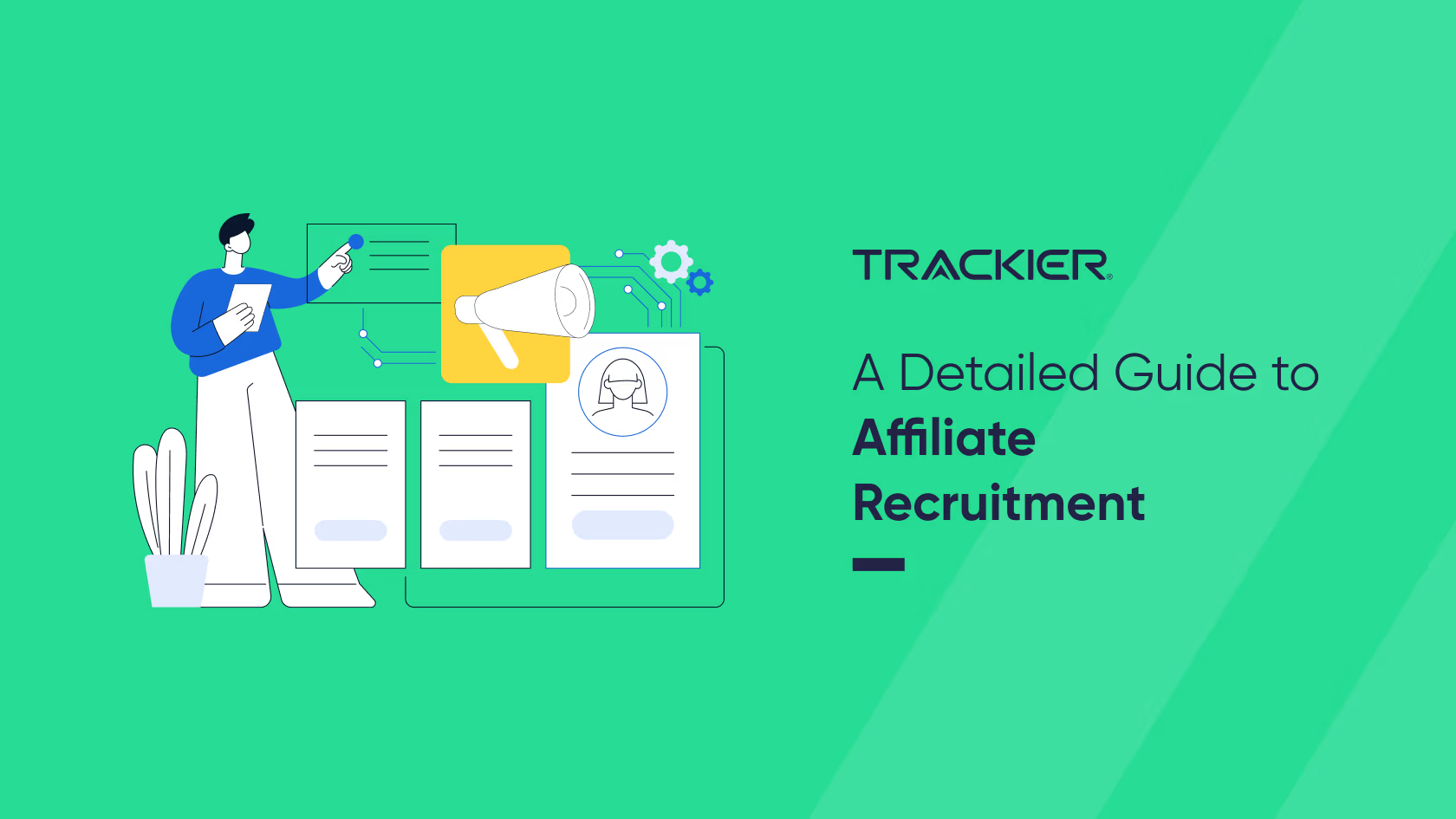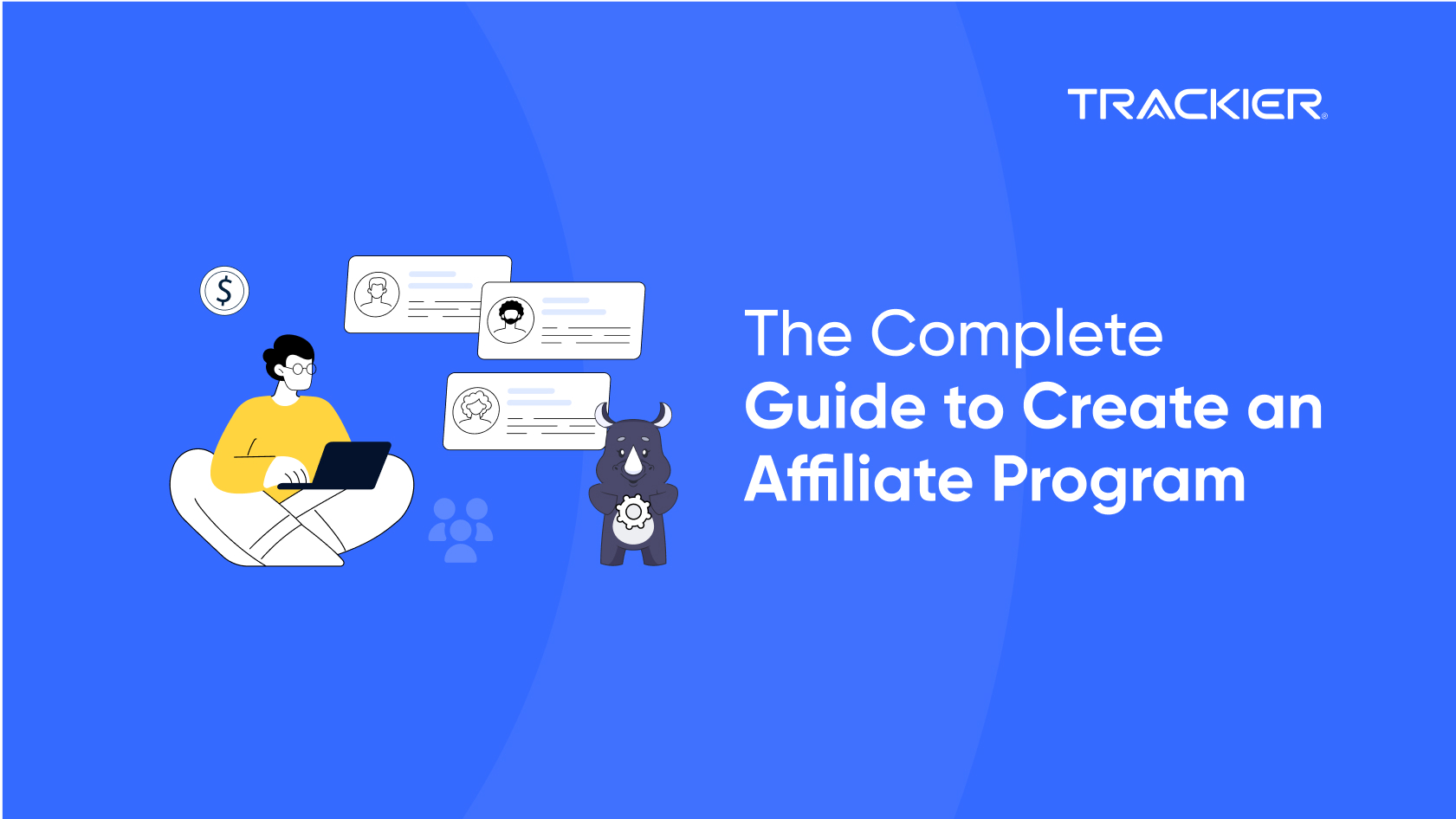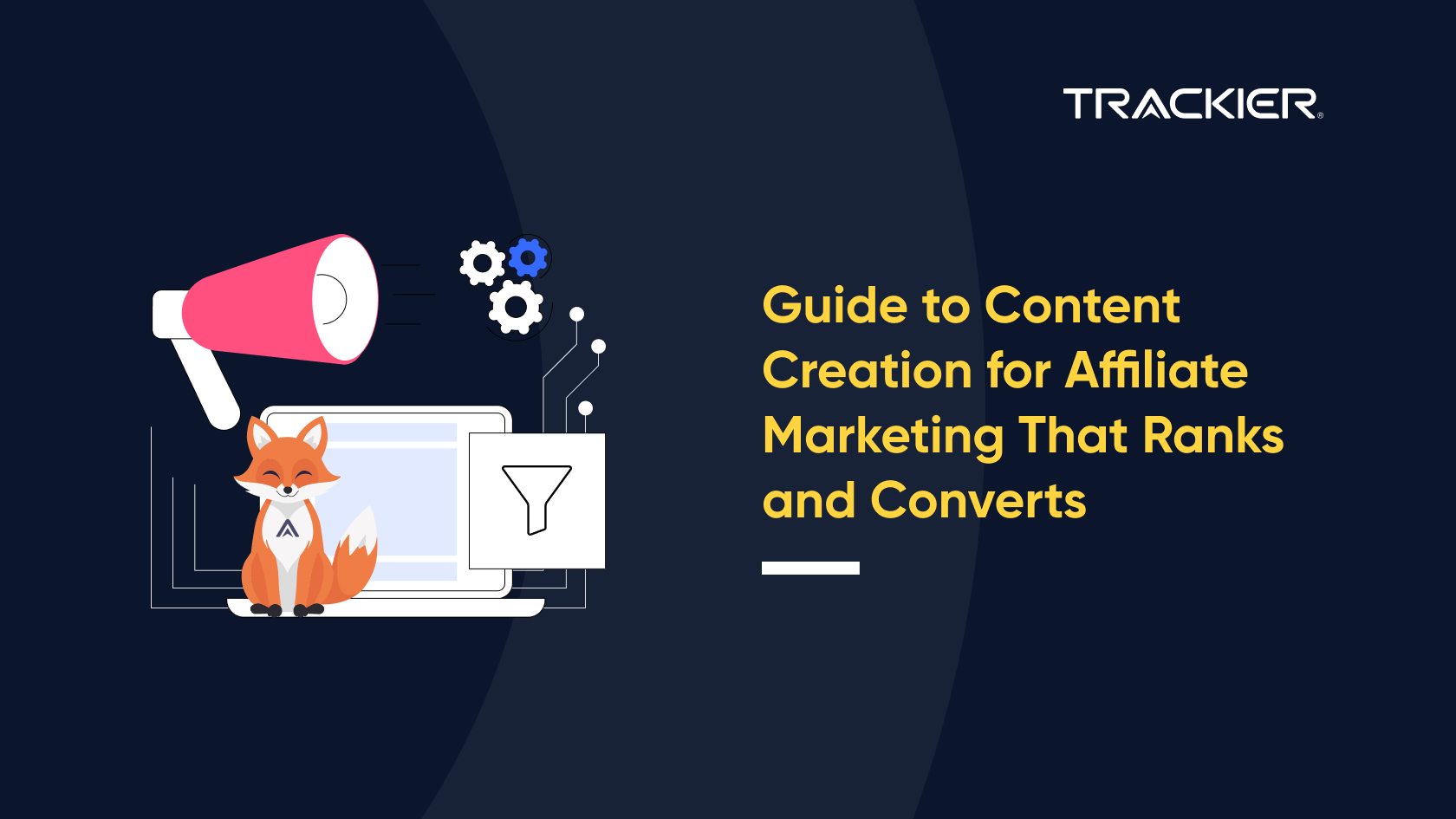A great affiliate program starts with affiliate recruitment. It’s the process of identifying, attracting, and collaborating with people or companies who can successfully market your brand. With the right affiliates, you can increase sales, reach a wider audience, and build brand credibility without having to pay for traditional advertising.
However, finding affiliates that actually match your business requires more than just sending out open invitations. Research, focused outreach, and a distinct value proposition that appeals to qualified partners are all necessary. Brands that depend on random sign-ups frequently experience low engagement and poor performance.
For this reason, companies now use dedicated performance marketing software to speed up recruitment and track outcomes precisely. These solutions make outreach and onboarding easier, allowing you to concentrate on collaborations that generate real revenues.
What Is Affiliate Recruitment?
The practice of finding and collaborating with people or groups who may promote your goods or services in return for a commission is known as affiliate recruitment. These affiliates can be website owners, bloggers, influencers, or even companies whose consumers are similar to your target market.
The concept is to bring in affiliates that can deliver genuine traffic and conversions while protecting your brand’s image. Affiliate recruitment, as opposed to traditional advertising, promotes partnerships that are mutually beneficial rather than one-time promotions.
It’s also different from affiliate onboarding. The goal of affiliate recruitment is to find and get possible affiliates to join your program. Onboarding, on the other hand, starts as soon as they sign up and involves educating them about your products, policies, and compensation structure.

A well-planned recruitment procedure guarantees that you draw affiliates who are both active and relevant to your field. When implemented correctly, performance-based advertising creates a foundation for continued growth and steady revenue.
Why Affiliate Recruitment Matters
Affiliate recruitment plays a big role in how successful your program becomes. Your sales, visibility, and overall brand reputation are all directly impacted by the kind of affiliates you bring in. Regular visitors can become devoted clients if your affiliates truly connect with the audience you are targeting.
Getting the proper affiliates also contributes to your credibility. People are more likely to interact with your products or services when they see reputable creators or websites promoting your business. 81% of businesses rely on affiliate partnerships to increase exposure and conversions.
Strong affiliate recruitment also guarantees a consistent flow of content and exposure. Instead of spending lots of money on ads, you can rely on your affiliates to promote your brand across platforms, often in more personal and authentic ways. This helps in your sustainable growth while controlling marketing expenses.
In contrast, ineffective recruitment can end up in irrelevant traffic or inactive affiliates. Because of this, brands need to prioritize quality above quantity. Hundreds of inactive affiliates can be outperformed by even a small number of active, niche-relevant affiliates.
Affiliate recruitment involves more than just adding new members to your organization. It’s about picking partners who can make a measurable difference and who share your objectives.
The Affiliate Recruitment Process
It takes time to build a solid affiliate program. Finding affiliates who share your values requires preparation, time, and open communication. Here’s a simple explanation of how the affiliate recruitment process usually works.
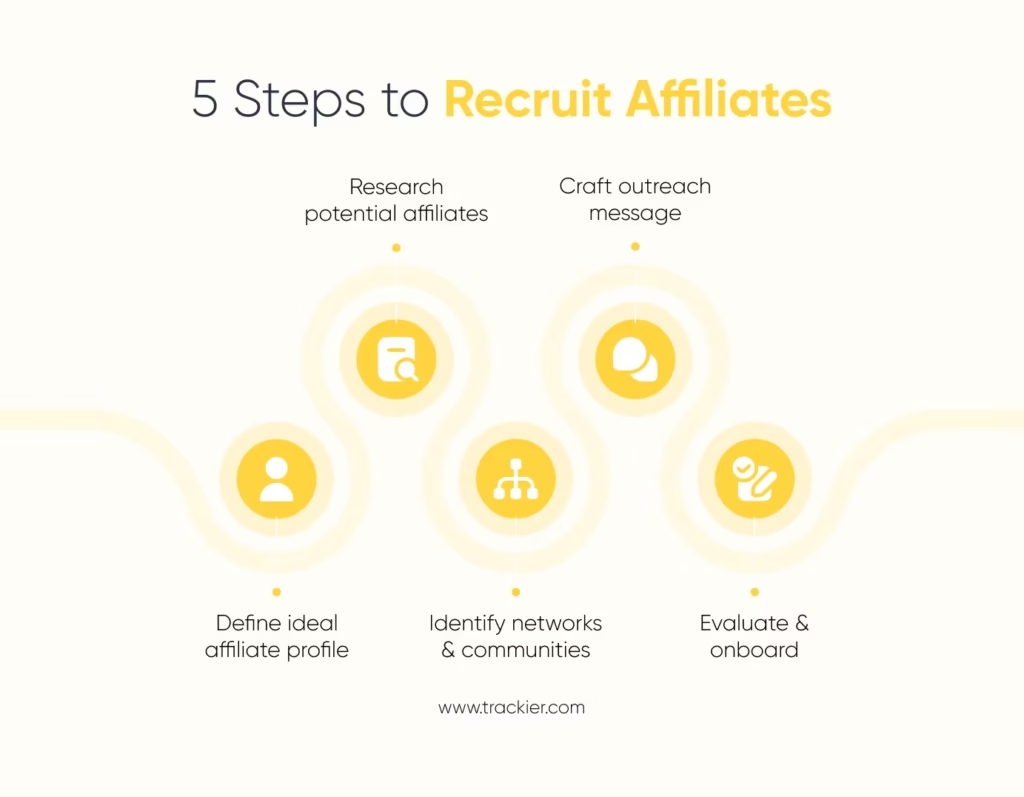
Step 1: Identify Your Perfect Affiliate Profile
Identify the type of affiliates you want before you start recruiting. Identify your target audience and the type of partners who can connect with them.
For example, if you sell exercise gear, search for fitness communities, YouTube trainers, or health bloggers who already interact with your target market.
Having a clear profile makes it easier to filter out affiliates who might not be a suitable fit, thus saving you time and effort.
Step 2: Browse Possible Affiliates
Once you’ve decided what you’re looking for, start your investigation. Find creators, websites, and micro-influencers that fit your niche by using search engines, social media sites, and affiliate directories.
You can also analyze your competitors’ affiliate programs to see who’s promoting them and what kind of content they create. This gives information on where your potential affiliates might be active and what drives them to sign up for a program.
Step 3: Identify Affiliate Networks and Communities
Many affiliates prefer to sign up for programs via reputable sites like ShareASale or Impact. You can reach a larger and more experienced pool of partners by listing your program on these networks.
You can also look for industry Slack communities, LinkedIn groups, and niche-specific forums where affiliates regularly share opportunities and work together.
Step 4: Create a Strong Outreach Message
A personal approach is necessary for affiliate recruitment. Send personalized messages that show a genuine interest in what they do rather than sending out bulk emails.
Briefly describe your brand, outline the potential benefits for both parties, and add significant details such as commission rates, product highlights, and tracking strategies.
Make sure your message is easy to read and friendly. The idea is to make the affiliate feel valued, rather than targeted for promotion.
Step 5: Assess and Integrate Affiliates
After you receive responses, spend time evaluating potential affiliates before enrolling them. Examine their content’s quality, audience relevance, and engagement rates.
Provide clear directions, promotional materials, and open communication regarding rewards and procedures after approval. A positive, long-lasting relationship is built by an easy onboarding procedure.
Finding the Right Partners
One of the most important elements of affiliate recruitment is finding affiliates who actually fit your brand. However, selecting them requires more than just looking at website traffic or follower counts. It includes finding people who share the same views and authentically communicate with your audience.
1. Start with Affiliate Recruitment Research
Affiliate recruitment research helps you understand where to find potential partners and what kind of content they create. Start by finding hashtags and phrases associated with your expertise on sites like YouTube, Instagram, or TikTok. This enables you to find creators who have previously discussed related goods or services.
You can also use SEO tools such as Ahrefs or SEMrush to locate websites that rank for keywords related to your brand. For example, if you are in the travel industry, look for travel bloggers or location review sites with a high domain authority. Because of their dedicated readership and expertise, they often become great affiliates.
2. Evaluate Your Current Audience
Your best affiliates could be existing members of your community. Examine your current clientele, social media following, and newsletter subscribers. People who already like your brand might be great promoters since they speak from experience. You can use referral campaigns or loyalty emails to get people to sign up for your affiliate program.
As these affiliates already have trust in your company, their promotions seem more real and relatable, which is why this strategy works so effectively.
3. Find Affiliate Networks and Marketplaces
Thousands of active affiliates from a variety of industries are hosted by affiliate networks. Joining these platforms helps you to reach a broader range of potential partners. Affiliates can also be selected according to audience type, area, niche, and performance indicators.
These networks make outreach and tracking easier, letting you concentrate more on building connections rather than handling technical details.
4. Study Competitor Affiliates
You can learn a lot about what works in your niche by investigating affiliate programs offered by competitors. Find out who is marketing similar products and how. You can examine the key referral sources and partnerships of competitors with the help of tools like SimilarWeb or SpyFu.
You can develop better offers or unique incentives to draw in similar or better affiliates by knowing what kinds of affiliates other companies collaborate with.
5. Assess Partner Compatibility
Before choosing an affiliate, consider how well they align with the tone, target demographic, and objectives of your business. Consider factors other than reach, such as audience demographics, engagement rate, and comment quality.
Ask queries like:
- Does their target market align with your own?
- Do they create genuine material or rely heavily on promotion?
- Have they already worked with similar brands?
Stronger outcomes and more meaningful partnerships are assured when you choose affiliates who actually care about your brand.
Successful affiliate recruitment depends on alignment rather than numbers. When you focus on relevance, authenticity, and shared goals, your affiliates convert into real collaborators who contribute to your brand’s ongoing growth.
5 Proven Affiliate Recruitment Strategies
Launching a program and waiting for sign-ups is not enough for affiliate recruitment. The correct techniques let you attract great partners who care about your brand and deliver long-term outcomes. Here are some useful affiliate recruiting strategies that you can implement right away.
1. Use Your Existing Customers and Advocates
Your current clients usually become your best supporters of the brand. They already know and trust your products, so their promotions are more authentic.
Sending a simple email invitation or posting a “Become an Affiliate” banner on your website will encourage people to join your affiliate program.
You can also offer special bonuses or increased commission rates to returning clients who suggest new users. This technique helps you expand organically while rewarding loyal customers.
2. Partner with Influencers and Content Creators
Influencers play an important part in affiliate marketing. They already have audiences who trust their recommendations, making them great partners for increasing conversions. Instead of focusing solely on follower counts, target micro and mid-tier influencers who engage specific audiences.
Reach out to them with tailored communications emphasizing how your product complements their content style. Offering early access, free trials, or special discount codes can boost your offer’s appeal and help you develop long-term partnerships.
3. Attend Affiliate Events and Online Communities
Affiliate marketing events, both online and offline, are great opportunities to meet new partners. Conferences and local networking gatherings expose you to experienced affiliates seeking new opportunities.
You can also join online communities like Reddit’s r/AffiliateMarketing, Facebook groups, and Slack channels where affiliates share advice and find new programs. Being involved in such events promotes visibility and trust with potential partners.
4. Offer Competitive Incentives and Transparent Commissions
Affiliates are more inclined to participate in initiatives that clearly define how and when they will be rewarded. Keep your commission structure basic yet competitive. Depending on your objectives, you can try out various models such as pay-per-sale (PPS), pay-per-click (PPC), and pay-per-lead (PPL).
Adding performance bonuses or tiered awards might help encourage affiliates to work harder. For example, you may give higher commissions to affiliates that achieve a set amount of monthly conversions. Transparency boosts confidence, making affiliates more inclined to stay active.
5. Use Data and Automation to Improve Recruitment
Tracking results helps you to figure out what works in your recruitment efforts. Use data to see which outreach channels generate the most affiliates and change your strategy accordingly.
Automating small elements of the process, such as follow-up emails or application tracking, can save time and guarantee that no potential partner is missed. Remember that recruitment still requires a personal touch. Automation must enhance your outreach, not replace it.
How to Recruit Affiliates for Different Niches
Affiliate recruitment is not a universal approach. Every niche has a unique audience, content style, and promotional strategy. Understanding how to adapt your strategy to each particular field lets you identify affiliates who are both relevant and effective.
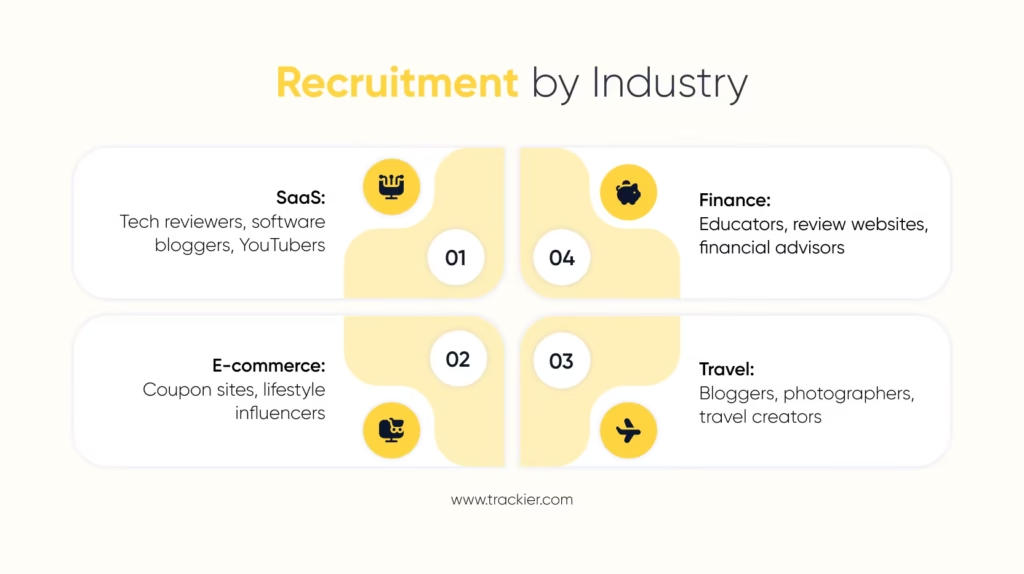
1. SaaS & Tech
SaaS and IT affiliates typically emphasize product features, problem resolution, and value-driven content. Bloggers, YouTubers, and software review websites are frequently the most effective partners here.
When reaching out to them, emphasize your product’s unique selling factors, such as time savings, adaptability, or customer support. Offering free trials or demo accounts might also motivate affiliates to write extensive reviews that demand trust from their audience.
2. E-commerce & Retail
Lifestyle influencers, discount sites, and comparison blogs make excellent affiliates for e-commerce sites. They have audiences that enjoy discovering new products and discounts.
You can attract them by providing exclusive discount codes, seasonal bonuses, or limited-time promotions. Affiliates in this area value competitive commissions and quick payouts, so being upfront will help you stand out from the crowd.
3. Travel & Lifestyle
Travel affiliates typically create content that includes experiences, recommendations, and trip guides. To find them, look for travel bloggers, photographers, and social media makers with genuine involvement rather than just a large following.
Provide them with marketing resources such as high-quality pictures and itinerary suggestions that are easily adaptable to their platforms. Collaborations, such as sponsored trips or content partnerships, are also successful strategies to strengthen ties.
4. Finance & Fintech
Finance affiliates have to be trustworthy and legally compliant as they frequently deal with sensitive areas such as investments, credit cards, and FX. Focus on bloggers, YouTubers, and instructors who have earned the trust of their audience.
When reaching out, be sure to clearly state the value of your product, compliance conditions, and payment arrangements. Providing correct product data and clear tracking can increase the appeal of your offer to professional affiliates in this field.
Best Practices for Recruiting New Affiliates
Hiring new affiliates takes time, effort, and some level of creativity. The method works best when you focus on making genuine connections rather than sending out mass outreach letters. Following a few easy best practices will help you stand out and attract affiliates who are eager to work with your business.
1. Personalize Every Outreach
Affiliates receive numerous offers, so a basic email will not capture their attention. Always spend a few minutes researching who you’re approaching. Mention something specific about their material, such as a recent blog post, video, or campaign.
A targeted approach shows that you appreciate their work and are not simply sending random invitations.
2. Keep Communication Simple and Clear
Avoid long introductions and technical language in your outreach. Instead, concentrate on what matters most, like how the partnership benefits them. Be open about commission rates, product specifications, and program policies.
Clear communication builds trust with affiliates and makes it easier for them to assess whether your service is a good fit for their goals.
3. Follow Up, But Don’t Spam
Following up is necessary, but it must be done carefully. If you don’t hear back after a week, send a brief and polite reminder. Keep it friendly and to the point, without requiring an instant response.
If they still don’t react, it’s time to move on. Forcing communication might harm your brand’s image and undermine your reputation among the affiliate community.
4. Offer Value Over Commissions
While commission rates are important, affiliates also value brand support. Give them access to marketing resources such as banners, product photos, and example captions. You can also give exclusive information about upcoming product launches to help them create better content.
Affiliates who feel supported are more likely to stay active and perform well over time.
5. Track and Learn from Every Campaign
Recruitment does not end when an affiliate signs up. Keep an eye on how various outreach strategies perform. Evaluate which emails, platforms, or events attract the most engaged affiliates.
Over time, this data helps you to improve your strategy and focus on the channels that produce the best results. Consistent improvement transforms affiliate recruitment from a one-time effort to a repeatable process.
Evaluating and Selecting the Right Affiliates
After receiving applications or responses, the next step is to determine which affiliates are a good fit for your program. Selecting the right ones helps you to retain brand consistency, eliminate low-quality traffic, and ensure that your program grows continuously.

1. Check Audience Relevance
Begin by determining whether the affiliate’s audience fits your target clients. Examine their social media profiles, website content, or YouTube channel themes. An affiliate with a smaller but more engaged following is frequently more valuable than one with a huge but unrelated audience.
2. Evaluate Content Quality
Content reveals a lot about how an affiliate promotes products. Check to see if their posts, blogs, and videos are informative and consistent. Avoid affiliates who use clickbait or spammy promotions, as they can damage your brand’s credibility.
3. Analyze Engagement and Performance Metrics
Numbers matter, but only the right ones. Instead of focusing solely on follower count, consider engagement rate, comments, and traffic quality. Tools and even manual checks on post interactions can offer valuable insights.
Ask for previous campaign performance or testimonials, if available. Affiliates who have previously driven conversions are more likely to achieve consistent results.
4. Review Reputation and Brand Alignment
See if the affiliate’s online reputation matches your brand’s values. Check out their comment sections, previous collaborations, and audience feedback. Any signs of controversy or misleading content may be a red flag.
5. Start with a Short Trial
If you are unsure, start with a short trial campaign. Before fully onboarding an affiliate, set a specific goal for them, such as generating a certain number of leads or conversions. This helps both parties understand the expectations and potential performance.
Onboarding and Retaining Affiliates
Once you’ve found the right affiliates, the next important step is to onboard them. A well-structured onboarding process ensures affiliates understand your brand, goals, and expectations, making it easier for them to begin promoting and driving results more quickly.
Affiliate Onboarding Process
Start by welcoming affiliates with a personalized email containing everything they need to get started:
- Program overview: Provide a summary of your brand, commission model, and payout frequency.
- Access to tools and creators: Provide tracking links, banners, product feeds, and brand guidelines.
- Training materials: Offer FAQs, tutorials, and channels of communication for prompt assistance.
- Performance expectations: Clearly define KPIs, conversion goals, and compliance requirements.
Building Long-Term Relationships
Retention is just as essential as recruitment. Once affiliates begin to perform, focus on increasing loyalty and trust.
- Maintain consistent communication: Affiliates can stay up to date on campaigns and promotions by checking in on a regular basis and receiving newsletters.
- Offer tiered incentives: Top performers can be rewarded with bonuses, early access to offers, or exclusive commission tiers.
- Recognize achievements: Publicly acknowledge high-performing affiliates in your community or on social media.
- Gather feedback: Speak with affiliates about their experiences and suggestions for making collaboration easier or more rewarding.
Tools and Platforms That Simplify Affiliate Recruitment
Managing affiliate recruitment manually can take several hours, from finding potential partners to tracking their performance. Using the appropriate tools makes the process more efficient, organized, and data-driven.
1. Affiliate Recruitment Tools
Affiliate recruitment tools let you find, filter, and connect with potential partners based on their niche, audience type, or performance data. They make outreach easier by revealing which affiliates are most likely to support your objectives. In addition, you can analyze engagement levels, track content quality, and organize outreach efforts all in one place.
2. CRM and Tracking Solutions
Once affiliates have been onboarded, it is critical to monitor their activities, communications, and conversions. This is where specialized platforms for tracking and management, such as Trackier, truly stand out.
Tools like Trackier help brands to manage affiliate recruitment, onboarding, and tracking all in one system. It allows you to monitor conversions, manage payouts, and track engagement in real time. By providing transparent data and performance insights, it ensures that affiliates and managers are still aligned.
3. Analytics Tools to Measure Recruitment Performance
Data is essential for improving your recruitment process. Analytics tools measure how effective your marketing effort is, which channels attract the most affiliates, and which types of partners perform best over time.
These findings optimize campaigns, adjust incentives, and focus on affiliates who provide the most value, making your program more profitable.
Common Challenges in Affiliate Recruitment
Even with the proper strategy, affiliate recruitment has its own set of challenges. Understanding these challenges early on enables brands to create stronger and more sustainable affiliate programs.

- Finding the Right Affiliates: One of the most difficult tasks is identifying affiliates who truly fit your niche. Many brands struggle with finding applicants with relevant audiences or good engagement. Without proper verification, this can result in wasted resources and poor campaign outcomes.
- Maintaining Regular Communication: Communication breakdowns can easily harm collaboration. Affiliates require timely updates on campaigns, offers, and policy changes. When communication is unclear, affiliates lose interest or fail to represent your brand.
- Tracking and Attribution Issues: Inaccurate tracking is another common complaint. If conversions are not properly recorded or payouts are delayed, affiliates may lose faith in your program. Using a reputable platform ensures transparent tracking, real-time reporting, and automated payouts, resulting in consistent and trustworthy performance data.
- Low Engagement or Inactive Affiliates: Sometimes, affiliates join but never actively promote your brand. This happens when they don’t fully understand your product or aren’t motivated to continue. Offering training materials, periodic incentives, and personalized support can help affiliates stay active and engaged.
- High Competition in Recruitment: As affiliate marketing expands, brands from various industries compete for top-performing affiliates. This makes it more difficult to attract quality partners. Highlighting your commission structure and on-time payments can help your program stand out.
Future of Affiliate Recruitment
Affiliate recruitment is changing quickly. As digital marketing becomes more data-driven and personalized, brands’ methods for finding and managing affiliates evolve.
1. Work on Quality Over Quantity
Brands are shifting away from mass recruitment and toward affiliates who have genuine audience trust. A few high-performing partners can deliver better results than hundreds of low-engagement ones.
2. Data Driven Recruitment
Performance insights and analytics support recruitment decisions. Brands are using real-time data to evaluate affiliate performance, audience demographics, and conversion behavior before onboarding.
3. Automation and AI support
AI-powered tools speed up the affiliate recruitment process by analyzing engagement metrics, content types, and previous campaign results. Automation also streamlines tracking, payouts, and reporting, reducing the need for manual work.
4. Improved Brand-Affiliate Relationships
Future programs will emphasize community and collaboration. Instead of one-time promotions, affiliates will be viewed as long-term partners with common goals and creative freedom.
5. Transparent Tracking System
As privacy regulations get stricter, brands will turn to secure and transparent platforms for accurate attribution and compliance-friendly tracking.
Conclusion
Affiliate recruitment works best when brands prioritize quality partnerships, open communication, and equitable incentives. A thoughtful approach can help you attract motivated affiliates, improve collaboration, and achieve consistent results.
When properly managed, affiliate recruitment becomes a consistent growth channel that benefits both brands and partners.
FAQs
What is affiliate recruitment?
Affiliate recruitment is the process of identifying and partnering with individuals or businesses who will promote your products or services in exchange for a commission. It involves finding the appropriate affiliates, contacting them, and helping them with their initial setup. The goal is to create a trusted network of partners who can drive sales, leads, and traffic to their platforms.
What is an affiliate job?
An affiliate’s job is to promote a brand’s products or services via unique referral links. They receive a commission for each sale, lead, or action generated by their promotions. Affiliates frequently use blogs, social media, email marketing, and websites to reach out to potential customers and encourage them to buy or sign up using their link.
What are the three major types of affiliates?
Affiliates are classified into three types: content affiliates, coupon/deal affiliates, and influencer affiliates. Content affiliates promote blogs and SEO-driven articles, coupon affiliates distribute discounts and offers, and influencer affiliates promote products via social media platforms. Each type enables brands to reach different audience segments and achieve specific marketing objectives.
